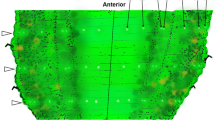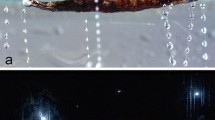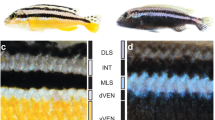Summary
Cephalopods generally are thought to have only static iridophores, but this report provides qualitative and quantitative evidence for active control of certain iridescent cells in the dermis of the squidLolliguncula brevis. In vivo observations indicate the expression of iridescence to be linked to agonistic or reproductive behavior. The neuromodulator acetylcholine (ACh) induced dramatic optical changes in active iridophores in vitro, whereas ACh had little effect on passive iridophores elsewhere in the mantle skin. Bath application of physiological concentrations of ACh (10-7M to 10-6M) to excised dermal skin layers transformed the active iridophores from a non-reflective diffuse blue to brightly iridescent colors, and this reaction was reversible and repeatable. The speed of change to iridescent in vitro corresponded well to the speed of changes in the living animal. Pharmacological results indicate the presence of muscarinic receptors in this system and that Ca++ is a mediator for the observed changes. Although ACh is present in physiological quantities in the dermal iridophore layer, it is possible that ACh release is not controlled directly by the nervous system because electrophysiological stimulation of major nerves in the periphery resulted in no iridescence inL. brevis; nor did silver staining or transmission electron microscopy reveal neuronal elements in the iridophore layer. Thus, active iridophores may be controlled by ACh acting as a hormone.
Similar content being viewed by others
References
Arnold JM (1967) Organellogenesis of the cephalopod iridophore: cytomembranes in development. J Ultrastruc Res 20:410–420
Atlas D, Adler M (1981) α-Adrenergic antagonists as possible calcium channel inhibitors. Proc Natl Acad Sci USA 78(2):1237–1241
Babcock DF, First NL, Lardy HA (1976) Action of ionophore A23187 at the cellular level. Separation of effects at the plasma and mitochondrial membranes. J Biol Chem 251(13):3881–3886
Bagnara JT (1958) Hypophyseal control of guanophores in anuran larvae. J Exp Zool 137(2):265–279
Bagnara JT, Hadley ME (1973) Chromatophores and color change. Prentice-Hall, Englewood Cliffs, NJ
Bagnara JT, Taylor JD, Hadley ME (1968) The dermal chromatophore unit. J Cell Biol 38:67–79
Brocco SL, Cloney RA (1980) Reflector cells in the skin ofOctopus dofleini. Cell Tissue Res 205:167–186
Butman BT, Obika M, Tchen T, Taylor JD (1979) Hormone-induced pigment translocations in amphibian dermal iridophores, in vitro: changes in cell shape. J Exp Zool 208:17–34
Carafoli E, Crompton M (1978) The regulation of intracellular calcium by mitochondria. Ann NY Acad Sci 307:269–284
Cloney RA, Brocco SL (1983) Chromatophore organs, reflector cells, iridocytes and leucophores in cephalopods. Am Zool 23:581–592
Cooper KM, Hanlon RT (1986) Correlation of iridescence with changes in iridophore platelet ultrastructure in the squidLolliguncula brevis. J Exp Biol 121:451–455
Cooper KM, Hanlon RT, Budelmann BU (1990) Physiological color change in squid iridophores. II. Ultrastructural mechanisms inLolliguncula brevis. Cell Tissue Res 259:15–24
Cormier MJ (1983) Calmodulin: the regulation of cellular function. In: Spiro TG (ed) Calcium in biology. John Wiley and Sons, New York, pp 53–106
Cott HB (1940) Adaptive coloration in animals. Methuen and Co. Ltd., London
Dubas F, Hanlon RT, Ferguson GP, Pinsker HM (1986) Localization and stimulation of chromatophore motoneurons in the brain of the squid,Lolliguncula brevis. J Exp Biol 121:1–25
Ferguson GP, Martini FM, Pinsker HM (1988) Chromatophore motor fields in the squid,Lolliguncula brevis. J Exp Biol 134:281–295
Florey E (1969) Ultrastructure and function of cephalopod chromatophores. Am Zool 9:429–442
Florey E, Cahill MA (1980) Cholinergic motor control of sea urchin tube feet: evidence for chemical transmission without synapses. J Exp Biol 88:281–292
Florey E, Kriebel ME (1969) Electrical and mechanical responses of chromatophore muscle fibers of the squid,Loligo opalescens, to nerve stimulation and drugs. Z Vergl Physiol 65:98–130
Florey E, Dubas F, Hanlon RT (1985) Evidence for L-glutamate as a transmitter substance of motoneurons innervating squid chromatophore muscles. Comp Biochem Physiol 82(C):259–268
Hadley ME (1987) Calcium-dependent irreversible effect of ionophore A23187 on melanophores. Pigment Cell Res 1:57–61
Hadley ME, Goldman JM (1970) The physiological regulation of the amphibian iridophore. J Invest Dermatol 54:88
Hanker JS, Thornburg LP, Yates PE, Moore III HG (1973) The demonstration of cholinesterases by the formation of osmium blacks at the sites of Hatchett's brown. Histochemie 37:223–242
Hanlon RT (1982) The functional organization of chromatophores and iridescent cells in the body patterning ofLoligo plei (Cephalopoda: Myopsida). Malacologia 23(1):89–119
Hanlon RT, Messenger JB (1988) Adaptive coloration in young cuttlefish (Sepia officinalis L.): the morphology and development of body patterns and their relation to behaviour. Phil Trans R Soc Lond [Biol] 320:437–487
Hanlon RT, Hixon RF, Hulet WH (1983) Survival, growth, and behavior of the loliginid squidsLoligo plei, Loligo pealei, andLolliguncula brevis (Mollusca: Cephalopoda) in closed sea water systems. Biol Bull 165(3):637–685
Holmes W (1943) Silver staining of nerve axons in paraffin sections. Anat Rec 86:157–185
Howell BJ, Gilbert DL (1976) pH-temperature dependence of the hemolymph of the squid,Loligo pealei. Comp Biochem Physiol 55A:287–289
Ide H (1973) Effects of ACTH on melanophores and iridophores isolated from bullfrog tadpoles. Gen Comp Endocrinol 21:390–397
Kasukawa H, Oshima N, Fujii R (1986) Control of chromatophore movements in dermal chromatic units of blue damselfish — II. The motile iridophore. Comp Biochem Physiol 83 C:1–7
Kawaguti S, Ohgishi S (1962) Electron microscopic study on iridophores of a cuttlefish,Sepia esculenta. Biol J Okayama Univ 8:115–129
Messenger JB (1974) Reflecting elements in cephalopod skin and their importance for camouflage. J Zool Lond 174:387–395
Messenger JB (1979) The eyes and skin ofOctopus: compensating for sensory deficiencies. Endeavour 3:92–98
Messenger JB, Miyan JA (1986) Neural correlates of colour change in cuttlefish. J Exp Biol 125:395–400
Mirow S (1972) Skin color in the squidsLoligo pealii andLoligo opalescens. II. Iridophores. Z Zellforsch 125:176–190
Moynihan M (1985) Communication and noncommunication by cephalopods. Indiana University Press, Bloomington, IN
Novales RR (1977) The effect of the divalent cation ionophore A23187 on amphibian melanophores and iridophores. J Invest Dermatol 69:446–450
Oshima N, Sato M, Kumazawa T, Okeda N, Kasukawa H, Fujii R (1985) Motile iridophores play the leading role in damselfish coloration. In: Bagnara J, Klaus SN, Paul E, Schartl M (eds) Pigment Cell 1985: Biological, molecular and clinical aspects of pigmentation. University of Tokyo Press, Tokyo, pp 241–246
Packard A, Hochberg FG (1977) Skin patterning inOctopus and other genera. Symp Zool Soc Lond 38:191–231
Prozialeck WC, Weiss B (1985) Mechanisms of pharmacologically altering calmodulin activity. In: Rubin RP, Weiss GB, Putney Jr. JW (eds) Calcium in biological systems. Plenum Press, New York London, pp 255–264
Rubin RP (1982) Calcium and cellular secretion. Plenum Press, New York London
Rubin RP (1985) Historical and biological aspects of calcium action. In: Rubin RP, Weiss GB, Putney JW (eds) Calcium in biological systems. Plenum Press, New York London, pp 5–33
Taylor JD (1969) The effects of intermedin on the ultrastructure of amphibian iridophores. Gen Comp Endocrinol 12:405–416
Taylor SE, Teague RS (1976) Thebeta adrenergic receptors of chromatophores of the frog,Rana pipiens. J Pharmacol Exp Ther 199(1):222–235
Winkelmann RK, Schmit RW (1957) A simple silver method for nerve axoplasm. Proc Staff Meet Mayo Clinic 32:217–222
Young RE, Arnold JM (1982) The functional morphology of a ventral photophore from the mesopelagic squid,Abralia trigonurd. Malacologia 23(1):135–163
Author information
Authors and Affiliations
Rights and permissions
About this article
Cite this article
Hanlon, R.T., Cooper, K.M., Budelmann, B.U. et al. Physiological color change in squid iridophores. Cell Tissue Res. 259, 3–14 (1990). https://doi.org/10.1007/BF00571424
Accepted:
Issue Date:
DOI: https://doi.org/10.1007/BF00571424




